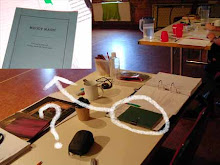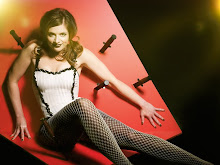 Thursday morning. Yesterday was detailing; that means today is the run.
Thursday morning. Yesterday was detailing; that means today is the run.The scheduled beginning time for the run is 10.30. There is a whole line of chairs set up at the back of the room when everybody arrives. The mere suggestion of an audience raises the ante. They are for a group of Malthouse permanent staff that are due to attend the run. The atmosphere in the room is more formal, and Darren, the Stage Manager also takes on a suitably more formal tone.
The tension in the room is a higher today, but it's manifesting itself more in focus than in efforts to release. It's an interesting curve of rising and lowering tensions that show themselves in the final stages of a rehearsal process.
I was talking to Matt Wilson about show anxiety. I bring up a thought from one of David Mamet's books that the nervousness of performing in public IS the fundamental energy of theatre. The stakes of being humiliated or adored are extraordinarily high. Without that fear, theatre is boring. The actors need to be scared. I often find myself relating this notion to nervous performers when they think they're under-prepared. (Although I have been told that my interpretation of these comments is a bit skewed.)
Matt says that it is a similar phenomenon with stuntmen. He tells me that stuntmen need to be scared before they perform a stunt. The fear keeps them alert to potential dangers, it keeps their survival instinct intact. They need to stay completely safe because they need to be able to get up the next day and do the stunt again. It occurs to me that their recognition of the danger resonates through the performance of the stunt. If the stuntman doesn't embody the potential danger, perhaps it's not as exciting for the audience.

The daredevil though, is a different breed, he says. The daredevil isn't scared. The daredevil has no survival instinct to stop them from getting hurt. If they crash and burn it's part of the experience, the lifestyle, the reason they do it. This is also exciting for an audience, or perhaps thrilling is a more accurate word, but possibly self-destructive for the daredevil. The conversation left me wondering whether some actors are stuntmen, and others daredevils.
The stakes raised by the Malthouse company staff fires the run. It feels like several steps advanced from anything the show has been before. It's a huge release of tension, and Darren calls lunch.
But, the release of tension at the good run is shortlived; after lunch it's back into details. There's still heaps of work. Heaps of technical details, plenty of moments that will need more detailing before they're ready. What needs work is pretty crystal, and Mark tells me later that the afternoon's work feels good. Friday's run is cancelled in favour of detailing. At this stage it feels that the notion of the 'whole' is now pretty solid in everybody's performances. It's the details within scenes that is now the priority.
Tomorrow is the last day of rehearsal before production week. Lawrence is here again, and I'll catch up with Wardrobe and to see how they're getting on. Next week most of the work will be done in the theatre. It's a highly technical show. There's the ocassional sign from the cast that they're worried about just how technical the show is going to be, and whether there's enough time to master the technical details. But for now, they are going hard on mastering the scenic moments. Tick, tock, tick, tock.






